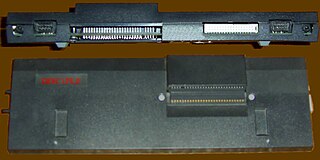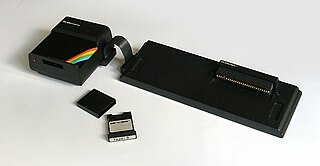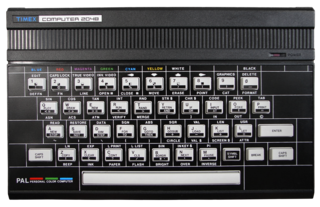The DISCiPLE and +D
As the ZX Spectrum became hugely popular, the lack of a mass storage system became a problem for more serious users. While Sinclair's response, the ZX Interface 1 and ZX Microdrive, was very cheap and technologically innovative, it was also rather limited. Many companies developed interfaces to connect floppy disk drives to the ZX Spectrum, one of the most successful being the Opus Discovery; however, these were all to some degree incompatible with Sinclair's system.
MGT's approach was different. It produced two different floppy-disk interfaces for the Spectrum, first the DISCiPLE (marketed by Rockfort Products) and later the cut-down +D interface (marketed by MGT themselves). Both, however, shared certain features:
The latter generated a non-maskable interrupt, freezing any software running on the Spectrum and allowing it to be saved to disk. This made it simple to store tape-based games on disk, to take screenshots and to enter cheat codes. A duplicate expansion connector at the back allowed other peripherals to be daisy chained, although the complexity of the DISCiPLE meant that many would not work correctly.
However, the real innovation was in the ROM. Unlike most of the competing systems, this was compatible with the Sinclair's extended ROM, meaning that the same BASIC commands used to operate Microdrives or the ZX Printer now could control floppy disk drives or a standard parallel printer. As well as being BASIC-compatible, it also mimicked the machine code entry points in the ZX Interface 1 - the so-called "hook codes". This meant that any Microdrive-specific software could use floppy disk drives connected to MGT interfaces instead without modification, provided the hook codes were used. The floppy drives simply appeared to Microdrive-aware applications to be very big, fast Microdrives.
Sinclair's Microdrive command syntax was so complex that a selling point of many disk interfaces was that their commands were simpler. While loading from tape required a simple:
LOAD "progname"
the equivalent Microdrive syntax was:
LOAD *"m";1;"progname"
Given the complexity of entering punctuation on the Spectrum's tiny keyboard, this was cumbersome. In addition to supporting the Sinclair syntax, MGT's code reduced the command to:
LOAD d1"progname"
Later, MGT produced the Lifetime Drive range of floppy disk drives (later named Universal Drive after concerns about warranty expectations). The drive was advertised as being compatible with major systems on the market at the time and comprised four models (3.5" and 5.25", with and without their own power supplies). Compatibility with various machines was achieved using a DIP switch and computer-specific cables.

The Amstrad CPC is a series of 8-bit home computers produced by Amstrad between 1984 and 1990. It was designed to compete in the mid-1980s home computer market dominated by the Commodore 64 and the Sinclair ZX Spectrum, where it successfully established itself primarily in the United Kingdom, France, Spain, and the German-speaking parts of Europe.
The Sinclair QL is a personal computer launched by Sinclair Research in 1984, as an upper-end counterpart to the ZX Spectrum. The QL was aimed at the serious home user and professional and executive users markets from small to medium-sized businesses and higher educational establishments, but failed to achieve commercial success. While the ZX Spectrum has an 8-bit Zilog Z80 as the CPU, the QL uses a Motorola 68008. The 68008 is a member of the Motorola 68000 family with 32-bit internal data registers, but an 8-bit external data bus.

The ZX Spectrum is an 8-bit home computer that was developed by Sinclair Research. It was released in the United Kingdom on 23 April 1982, and became Britain's best-selling microcomputer.
The Multiface was a hardware peripheral released by Romantic Robot for several 1980s home computers. The primary function of the device was to dump the computer's memory to external storage. Pressing a red button on the Multiface activated it. As most games of the era did not have a save game feature, the Multiface allowed players to save their position by saving a loadable snapshot of the game. Home computer software of the early 1980s was typically loaded into RAM in one go, with copy protection measures concentrating the loading phase or just after it. The snapshot feature could be used after copy protection routines had been executed, to create a backup that was effectively unprotected against unauthorised distribution. Later models of the Multiface mitigated this by requiring the device to be present when re-loading the dumps into memory, making the dumps useless to people without a Multiface. Software producers also reacted to the threat by using routines that would prevent execution of the product if it detected that a Multiface was present and by loading the software in multiple parts, thus requiring the presence of the original, copy-protected media.

The SAM Coupé is an 8-bit British home computer that was first released in late 1989. It was based on and designed to have compatibility with the Sinclair ZX Spectrum 48K and marketed as a logical upgrade from the Spectrum. It was originally manufactured by Miles Gordon Technology (MGT), based in Swansea in the United Kingdom.
Sinclair BASIC is a dialect of the programming language BASIC used in the 8-bit home computers from Sinclair Research and Timex Sinclair. The Sinclair BASIC interpreter was made by Nine Tiles Networks Ltd.

The Didaktik was a series of 8-bit home computers based on the clones of Intel 8080 and Zilog Z80 processors produced in former Czechoslovakia.

The DISCiPLE is a floppy disk interface for the Sinclair ZX Spectrum home computer. Designed by Miles Gordon Technology, it was marketed by Rockfort Products and launched in 1986.
The +D was a floppy disk and printer interface for the Sinclair ZX Spectrum home computer, developed as a successor to Miles Gordon Technology's earlier product, the DISCiPLE. It was designed to be smaller, cheaper, simpler and thus more reliable.

A peripheral from Sinclair Research for its ZX Spectrum home computer, the ZX Interface 1 was launched in 1983. Originally intended as a local area network interface for use in school classrooms, it was revised before launch to also act as the controller for up to eight ZX Microdrive high-speed tape-loop cartridge drives. It also included a DE-9 RS-232 interface capable of operating at up to 19.2 kbit/s. At hardware level it was fundamentally a voltage adaptor, the serial protocol being implemented in software by bit-banging. This led to problems when receiving data, but not when transmitting.

The ZX Microdrive is a magnetic-tape data storage system launched in July 1983 by Sinclair Research for its ZX Spectrum home computer. It was proposed as a faster-loading alternative to the cassette and cheaper than a floppy disk, but it suffered from poor reliability and lower speed.
Timex Sinclair was a joint venture established in December 1982 between the British company Sinclair Research and Timex Corporation in an effort to gain an entry into the rapidly growing early-1980s home computer market in North America.

The FD1771, sometimes WD1771, is the first in a line of floppy disk controllers produced by Western Digital. It uses single density FM encoding introduced in the IBM 3740. It is packaged in a 40-pin DIP. Later models in the series added support for MFM encoding and increasingly added onboard circuitry that formerly had to be implemented in external components. Originally packaged as 40-pin dual in-line package (DIP) format, later models moved to a 28-pin format that further lowered implementation costs.

Beta BASIC is a BASIC interpreter for the Sinclair Research ZX Spectrum microcomputer, written by Dr Andrew Wright in 1983 and sold by his one-man software house BetaSoft. BetaSoft also produced a regular newsletter/magazine, BetaNews.
Format Publications published Format magazine, a newsletter for ZX Spectrum and SAM Coupé users.

The Timex Computer 2048 or TC 2048 is a 1984 computer developed by Timex Portugal, at the time part of Timex Sinclair. It was based on the Timex Sinclair 2048 prototype, with a similar redesign case, composite video output, Kempston joystick interface, and additional video modes, while being highly compatible with the Sinclair ZX Spectrum computer.
The ZX Spectrum's software library was very diverse. While the majority of the software produced for the system was video games, others included programming language implementations, Sinclair BASIC extensions, databases, word processors, spread sheets, drawing and painting tools, and 3D modelling tools.
TR-DOS is a disk operating system for the ZX Spectrum with Beta Disc and Beta 128 disc interfaces. TR-DOS and Beta disc were developed by Technology Research Ltd (UK), in 1984.

Beta Disk Interface is a disk interface for ZX Spectrum computers. It was developed by Technology Research Ltd., in 1984 and released in 1985 with price £109.25. Beta 128 Disk Interface is a 1987 version supporting ZX Spectrum 128 machines. Beta disk interfaces were distributed with TR-DOS operating system in ROM, also attributed to Technology Research Ltd. Latest firmware version is 5.03 (1986). The interface was based on the WD1793 chip.











